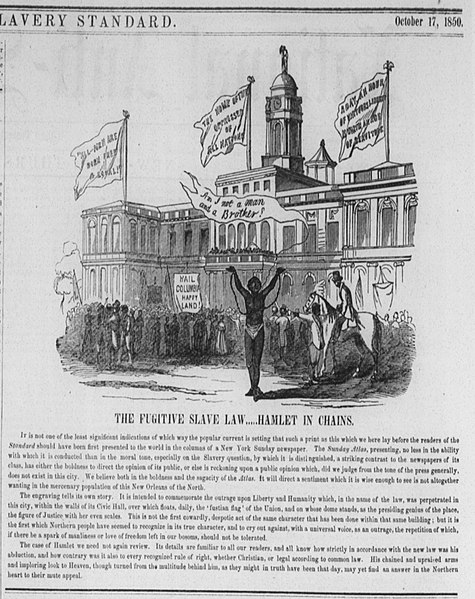Thomas Sims was an African American who escaped from slavery in Georgia and fled to Boston, Massachusetts, in 1851. He was arrested the same year under the Fugitive Slave Act of 1850, had a court hearing, and was forced to return to enslavement. A second escape brought him back to Boston in 1863, where he was later appointed to a position in the U.S. Department of Justice in 1877. Sims was one of the first slaves to be forcibly returned from Boston under the Fugitive Slave Act of 1850. The failure to stop his case from progressing was a significant blow to the abolitionists, as it showed the extent of the power and influence which slavery had on American society and politics. The case was one of many events leading to the American Civil War.
Portrait of Thomas Sims
Original caption: “Boston police and night watch conveying the fugitive slave, Sims, to the vessel.” Engraving from Gleason's Pictorial Drawing-Room Companion, 1851.
Broadside announcing the first anniversary of Thomas Sims' kidnapping in Boston
Fugitive Slave Act of 1850
The Fugitive Slave Act or Fugitive Slave Law was a law passed by the 31st United States Congress on September 18, 1850, as part of the Compromise of 1850 between Southern interests in slavery and Northern Free-Soilers.
An April 24, 1851 poster warning the "colored people of Boston" about policemen acting as slave catchers.
Print by E. W. Clay, an artist who published many proslavery cartoons, supports the Fugitive Slave Act of 1850. In the cartoon, a Southerner mocks a Northerner who claims his goods, several bolts of fabric, have been stolen. "They are fugitives from you, are they?" asks the slaver. Adopting the rhetoric of abolitionists, he continues, "As to the law of the land, I have a higher law of my own, and possession is nine points in the law."
The Vicksburg Whig did not cite any sources for these claims about the number of fugitives from American slavery ("Slaves Escaping from the South", January 16, 1861)
James Hamlet, the first man re-enslaved under the Fugitive Slave Law of 1850, in front of New York City Hall. The banner on the right reads: "A day, an hour, of virtuous liberty is worth an age of servitude".







